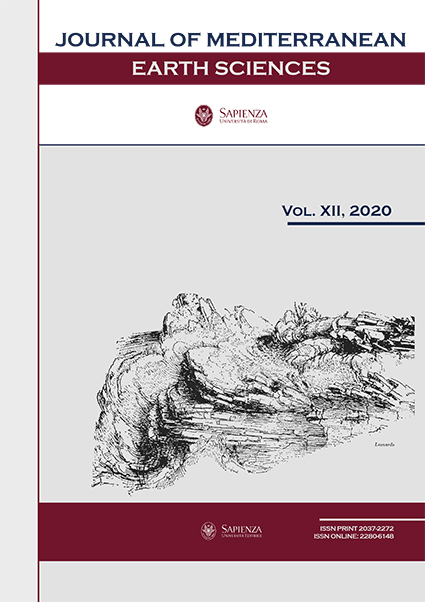Late Cretaceous to early Miocene evolution of the Southern Prenestini Mountains (Central Apennines): from fault-block platforms to carbonate ramp
DOI:
https://doi.org/10.3304/jmes.2020.16860Keywords:
Apennines, Latium-Abruzzi Platform, Prenestini Mt., Platform drowning, condensed pelagites, Neptunian dykes, Facies analysisAbstract
The Latium-Abruzzi platform is a well-known large shallow water domain of Central Apennines, however the reconstruction of geometry and evolution of its western margin remains poorly known because it was involved into the out-of sequence Olevano-Antrodoco thrust system. The investigated area is located in the Prenestini Mountains, at the southernmost portion of the Sabina Domain, westward of the large Latium-Abruzzi Platform domain. Here isolated outcrops of Cretaceous to Neogene carbonate successions exhibit a complex history of shallow water carbonate production, drowning, erosive phases and condensed sedimentation within a tectonic-eustatic-controlled carbonate platform marginal domain. Stratigraphic and facies analyses allowed to recognize two main fault block platforms, respectively South-Eastern Prenestini (SEP) and South Western Prenestini (SWP) platforms which in turn have been disjointed into smaller blocks. The displacement of all these blocks can be referred to the widely recognized upper Cretaceous extensional tectonic phase.
In these Platforms, during the Paleocene-Eocene interval, the onset of pelagic environment, and the related condensed pelagites, coincides with main relative sea-level rise, whereas during the following falling stage the depositional surface, coming into the wave abrasion zone, was affected by high hydrodynamic energy and the produced pelagic carbonate was swept away or trapped in local depressions and/or within the fractures forming the neptunian dykes. The coarse-grained material, produced by the erosion of the fractured and articulated Cretaceous substrate, was reworked together with fragments of pelagites to form lenses of polygenic conglomerates resting on top of the Cretaceuos platform carbonates. In the Chattian to Aquitanian time interval, short phases of shallow water carbonate production were established during the sea-level fall, as testified by the larger benthic foraminiferal-rich carbonates, followed by erosion and reworking of the already produced sediments into the northern and more deep platform-to-basin zones.
Successively, during the Aquitanian to Serravallian time interval, an homoclinal ramp hosting the Guadagnolo Fm, developed on the drowned fault block platforms, suggesting that during the Neogene the articulated substrate was roughly smoothed by the onlapping marly deposits of the basal Guadagnolo Fm and could accommodate the subsequent bioclastic sedimentation allowing the development of a carbonate ramp depositional profile.
Downloads
Published
How to Cite
Issue
Section
License
The submission has not been previously published, nor is it before another journal for consideration (or an explanation has been provided in Comments to the Editor).


